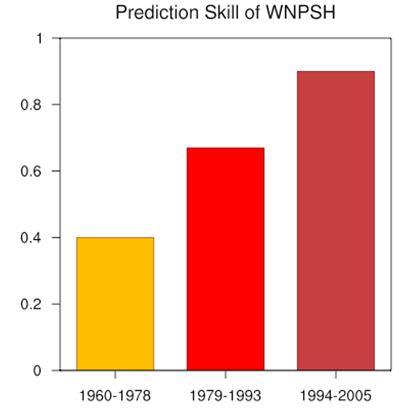As a key linkage of the East Asian summer climate and tropics, the western North Pacific (WNP) subtropical high (WNPSH) significantly affects summer rainfall over East Asia. Heavy rainfall and severe floods over East Asia, with the flood in 1998 in China being the most catastrophic one, are often associated with a westward and southward extension of the WNPSH. Thus, a better understanding of the predictability of the WNPSH would greatly favor for flooding and droughts related disaster mitigation.
For the summer prediction of the WNPSH, it is generally recognized that current coupled models exhibit a somewhat reliable capability. However, the WNP summer climate and associated tropical SSTs displayed remarkable interdecadal changes during recent decades. Do these interdecadal changes affect the seasonal prediction of the WNPSH? Will the seasonal predictability for the WNP summer climate also change on the similar time scale?
To address questions above, scientists from Institute of Atmospheric Physics and University of Reading (UK) performed a comprehensive assessment on the predictability of the WNPSH during recent 50 years, using state-of-the-art coupled models. They found that summer prediction of the WNPSH exhibits an interdecadal shift with higher prediction skills since the late 1970s, particularly after the early 1990s (Fig. 1). The prediction correlation during 1994-2005 reaches 0.90.

Fig. 1 Prediction skill of the WNPSH during different time periods (figure plotted by IAP)
Furthermore, they also investigated the possible reasons and found that better prediction of the WNPSH after the late 1970s may arise mainly from the improvement of the SST prediction around the tropical eastern Indian Ocean. And improvement after the 1990s is related to a dipole SST pattern over the Maritime Continent and the central equatorial Pacific Ocean.
Their work suggests that air-sea interactions related to the WNPSH become stronger during recent decades and thus improve predictability of the WNPSH. The results of the study provide a solid basis for future studies on uncertain change of the predictability.
The above findings were published in Climate Dynamics.
Reference:
Li, C., R. Lu, and B. Dong, 2016: Interdecadal changes on the seasonal prediction of the western North Pacific summer climate around the late 1970s and early 1990s. Clim. Dyn.,46, 2435-2448. doi:10.1007/s00382-015-2711-1.
http://link.springer.com/article/10.1007/s00382-015-2711-1
Contact: LI Chaofan, lichaofan@mail.iap.ac.cn






